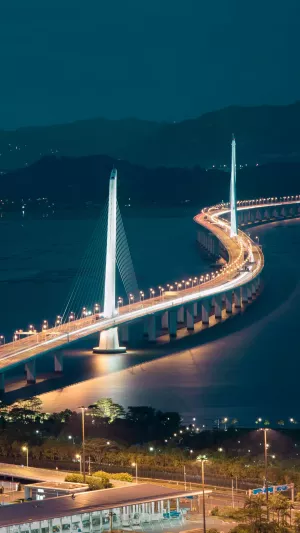Cross-sea bridges are engineering buildings designed to cross a strait or connect two locations, and are a form of cross-sea traffic passage.
Different from other large-scale projects, cross-sea bridges are constructed on the sea, and the construction methods of bridges are also completely different due to different lengths and complex geographical environments.
The longer the bridge, the more factors to be considered, so the basic technical requirements of the project are very high, and the bridge must be built with good hardware management.
In addition to improving the communication between the two places, it can also shorten travel time, and is conducive to the development of the surrounding land transportation.
Nowadays, with the advancement of engineering technology, the scale and form of sea-crossing bridges have also become diversified.
In addition to considering the safety and practicability of the bridge, if it has a unique style in appearance design, it can also become a representative building.
1. Seto Bridge, Japan
Japan's Seto Bridge, with a total length of 37.3 kilometers, is a general term for a total of 10 bridges spanning the Seto Inland Sea between Japan's Honshu and the four countries. It is also one of the three lines of the four-country bridge this week.
Construction of the Seto Bridge began in 1978 and took 9 years and 6 months, and it opened to traffic on April 10, 1988.
The total construction cost of this bridge is about 1 trillion and 133 billion yen. What is very special is that the Seto Bridge is a two-story road and rail bridge. The upper part is the 4-lane Seto Chuo Expressway, and the lower part is the JR Main Station Line.
It is the longest railway and road bridge in the world. The Seto Bridge was constructed using technologies that were first applied in the world at the time, such as underwater infinite blasting, and it was also the world's first bridge to build a railway on a large suspension bridge that is easily deformed by weather conditions and loads.
2. Chesapeake Bay Bridge, USA
The Chesapeake Bay Bridge in the United States is 37 kilometers long. Located in Maryland, USA, the bridge spans the Chesapeake Bay and connects rural areas on the state's east coast with urban areas on the west coast.
The five-lane Chesapeake Bay Bridge was first proposed by the state legislature in 1938, but construction didn't begin until 1949, and it finally opened to traffic in 1952.
The bridge was also expanded in 1973 due to the subsequent increase in traffic. In addition to connecting the east and west coasts, it is also an important part of US National Highways 50 and 301, connecting Baltimore, the Washington metropolitan area with Ocean City, Maryland, and other coastal tourist locations.
As a result, many tourists gather there, causing heavy traffic and becoming a traffic jam area.
3. King Fahd Bridge
The King Fahd Bridge, also known as the Bahrain Road Causeway Bridge, started construction in 1981 and lasted more than four years. It was completed and opened to traffic on November 25, 1986.
The bridge is located in the Gulf of Bahrain in the Persian Gulf and is a sea-crossing road connecting Bahrain and Saudi Arabia.
The total length of the bridge is 25 kilometers, of which 10 kilometers are reclaimed and the embankment part is connected by 5 bridges. The bridge deck has 4 lanes with a design speed of 100 kilometers per hour, and there are sidewalks on both sides.
Including auxiliary projects such as connecting roads, the entire project cost 1.2 billion US dollars, and all the funds were provided by Saudi Arabia.
4. Great Belt Bridge, Denmark
The Great Belt Bridge, Denmark, is a bridge connecting the Danish islands of Zealand and Funen across the Great Belt Strait.
The bridge consists of three parts, consisting of a parallel 6.8-kilometer suspension bridge from Zeeland to Spoo Island, a 7.41-kilometer submarine tunnel, and a 6.612-kilometer box girder bridge from Spoo Island to Funen Island, with a total length of 17.5 kilometers.
5. Øresund Bridge
The Øresund Bridge, connecting Copenhagen, Denmark and Malmö, the third largest city in Sweden, consists of 7.845 kilometers of bridges, 4.055 kilometers of artificial islands, and 4.05 kilometers of submarine tunnels, with a total length of 16 kilometers. The Øresund Bridge started construction in 1995 and was completed in May 2000.
It is currently the largest cable-stayed bridge built in the world. The budget for the construction of the Øresund Bridge was DKK 21 billion in 1990 prices.





